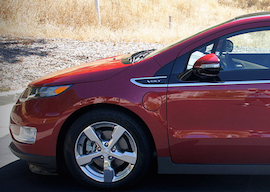I recently attended the Sustainable Brands New Metrics 2014 conference in Boston, which brought together executives, sustainability teams, supply chain managers, investors, brand strategists, and product designers to ask, “Why do companies and brands choose sustainability?”
Continuum brings a unique perspective to this question—we are experts in conducting user research, synthesizing research into design insights, and then manifesting these insights in compelling product, service, or system experiences. When we set out to consider a similar question—“Why do consumers choose sustainability?”—we uncovered core motivations consumers have that drive purchasing decisions for products and services positioned as the sustainable choice. Spoiler alert—the motivation is rarely environmental altruism, as Principal Kristin Heist explains in this video.
In this case, the user is a company or brand instead of a consumer, but the underlying strength of the user-centered design perspective remains. So, let’s dive in—how do we make sustainability work for companies?
The good news: awareness is no longer an issue. Over the past decade, thinking about sustainability within the executive suite (and, increasingly, the investment community) has evolved from that of a casually-dismissed non-issue to a material risk requiring attention. This is evidenced by a review of corporate reports by Andrew Winston at pivotgoals.com, who found that 150 of the Fortune 200 companies have some form of sustainability goals.
The bad news: business thinking about sustainability is still in its adolescence, with many competing frameworks and standards, but few commonly accepted best practices. Most of the focus and establishment of best practices is related to awareness—the measurement and reporting of environmental, social, and governance impacts. This is understandable—you have to start somewhere. Yet, awareness is rarely enough to result in the sustained behavior change required to set and achieve worthwhile sustainability goals. To succeed, companies need to consider the goals, motivations, and mental models of their employees.
So, why should a company set and achieve sustainability goals? Or, in other words, how does sustainability materially impact a company? Examples include: energy price risks, carbon regulatory risk, climate change risks, supply chain risks, talent acquisition and retention, brand risks/ opportunities, and activist investment and divestment in public companies. In support of these claims, a recent study at the Harvard Business School suggests that firms which include sustainability in their corporate strategy outperform less sustainable firms in the long-term. Some members of the investment community have also found that portfolios composed of more sustainable firms have a better risk/reward profile than market average.
Unfortunately, while many companies have some form of sustainability goals, fewer are setting goals that take full advantage of the available opportunities to mitigate risk and invest in their future. For example: Winston also found that only 25 of the Fortune Global 300 companies have carbon reduction goals aligned with Intergovernmental Panel on Climate Change (IPCC) findings, calling for greenhouse gas (GHG) emissions reductions of at least 85% in industrialized countries by 2050. Other Fortune Global 300 companies have set aspirational goals, such as “carbon-neutral” or “100% renewable energy,” without specifying any milestones or target date. To mitigate the most significant climate change risks (as well as carbon regulatory risks and energy price risks), companies need to have specific GHG goals aligned with IPCC findings.
For companies that do set and measure progress towards appropriate sustainability goals, these goals are often not achieved for a number of reasons.
One reason is a lack of support within the corporate power structure. Perhaps the executive team states sustainability as a priority… but it’s at the bottom of a list of many other, more important, priorities. Perhaps responsibility for setting, measuring, and achieving sustainability goals is delegated to an internal sustainability group (e.g., Environmental, Social, and Governance (ESG) group, or Corporate Social Responsibility (CSR) group)… but this group is isolated from the operation and strategy making of the company, with no real authority to drive internal change. Without an empowered sustainability leader or team, even the noblest of goals will not be achieved.
Another reason is a failure to consider employee experience. Employees are necessary partners in any plan of action for pursuing sustainability goals. If an ESG or CSR group pushes new processes or priorities onto employees who already have a long list of other responsibilities, adoption and adherence will likely remain low. As targets and deadlines are missed, these long-term, strategic goals may quietly fade into oblivion or have greatly reduced ambitions, and employees may be desensitized to future efforts.
Companies have successfully set and achieved impactful sustainability goals by embedding thinking about sustainability into their corporate strategy and processes. For example: BASF is using sustainability as a driver of innovation by targeting low sustainability performers in their large chemical portfolio; Autodesk and EMC have both achieved significant GHG emission per unit revenue reductions aligned with IPCC recommendations by following the C-FACT framework—an emerging standard for GHG emission goal-setting. Tiffany & Co.’s small, but empowered CSR team has worked with internal partners to integrate sustainability into its business practices, from more responsible sourcing of its gemstones and metals to reducing its operational footprint.
Continuum sees several ways in which our robust, user-centered design process can help companies with their sustainability strategy.
First, we can work with companies to make products and services that both work for people and are consistent with a company’s sustainability strategy and long-term goals. For instance, the consumer non-durable (CND) goods that we encounter many times each day can be reformulated or repackaged to create a better experience for consumers with reduced environmental impacts. We can also leverage this expertise to help companies internalize a user-centered design approach that includes sustainable thinking as an asset in the design process, rather than a hindrance to overcome down the road.
Additionally, we can work with companies to improve their employee experience with regards to internal changes required for the successful implementation and execution of a sustainability strategy. As an example of the value that can be derived from designing for employee experience, check out our work on redesigning the experience of call center employees. Only by moving beyond awareness—considering the goals, motivations, and mental models of employees and customers—can companies actually successfully execute a sustainability strategy and reap the resulting material benefits.




